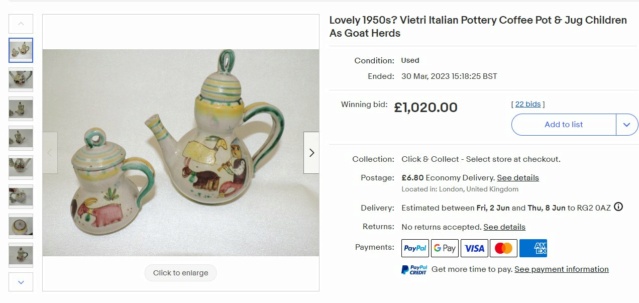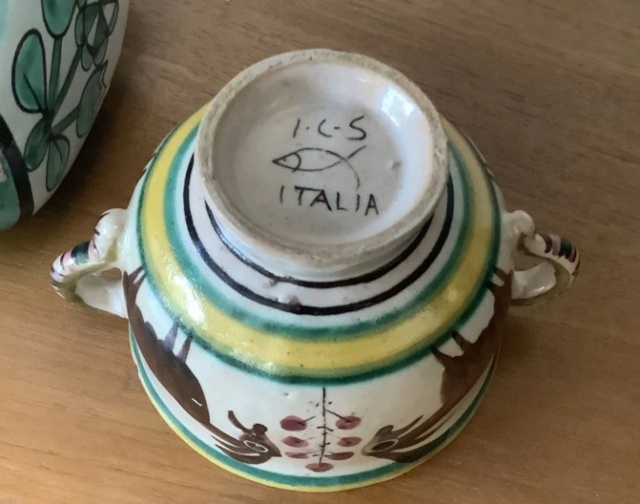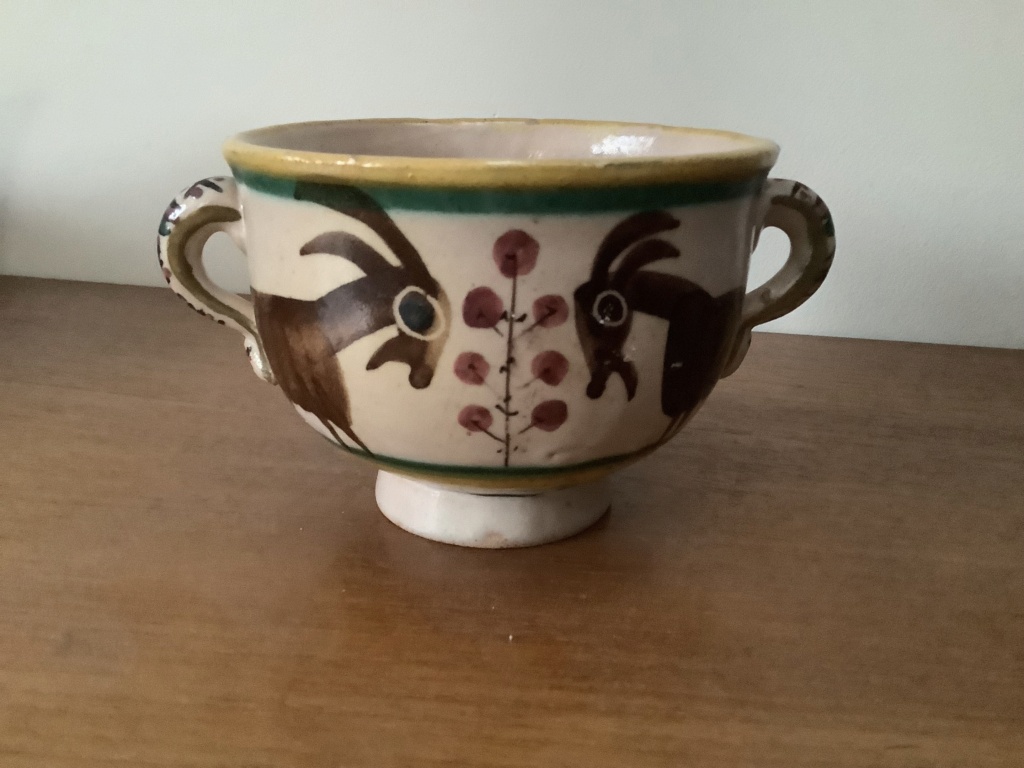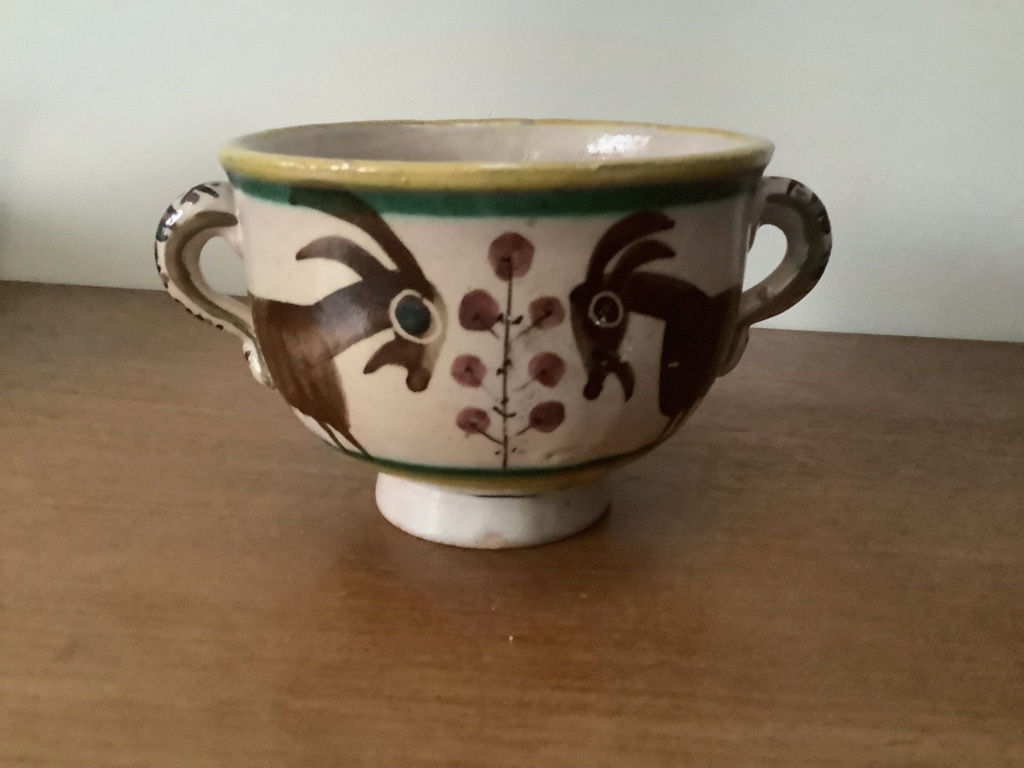Pot signed ICS Italia and fish mark - Industria Ceramica Salernitana, Italy
3 posters
Page 1 of 1

ummedia- Number of posts : 31
Location : Oxford
Registration date : 2014-09-11
 Re: Pot signed ICS Italia and fish mark - Industria Ceramica Salernitana, Italy
Re: Pot signed ICS Italia and fish mark - Industria Ceramica Salernitana, Italy
Best to upload the other two pots onto separate threads and include photos of their bases even if there's no mark.
_________________
Carrot cake is just fake cake
 Re: Pot signed ICS Italia and fish mark - Industria Ceramica Salernitana, Italy
Re: Pot signed ICS Italia and fish mark - Industria Ceramica Salernitana, Italy
The pot with the donkey appears to by I.C.S. Industria Ceramica Salernitana but the writer cautions against fakes
Walter Del Pellegrino wrote:
I.C.S.
Industria Ceramica Salernitana
1927 – 1940
Without doubt, the most important, the most collectible, the most expensive and the most forged mark of all the twentieth century ceramic art studios of Campania.
In 1927, Berlin-born, Moses Malamerson, better known to the art world as Max, arrived in Vietri Sul Mar and established a ceramics studio. It was a monumental moment in ceramics history. His ICS factory was a magnet for the Teutonic émigrés settling along the Amalfi coast beginning in the first half of the 20th century. ICS became the foundation for an entirely new and distinctive form of ceramics art that melded the traditional themes of nature captured by native Campanian artists (sea-life, animals, cliff-side panoramas, etc) for centuries with the experimental art forms sweeping Europe at the time.
ICS is the only mark that can claim the honor of having employed all the famous artists of the German (Tedesco) Period. The list includes Studemann, Kowalski, Hannasch, Dolker, Cassetta, Gambone, Procida, Giovannino and others.
Max Malamerson was not an artist. He was a businessman and a premier art collector of the highest order. As an entrepreneur Max knew that it was not enough to merely gather about him the best of the best. He needed a means of bringing attention to his enterprise.
Prior to the end of World War II the Amalfi coast was largely undiscovered by European and American tourist and it did not appear in guide books of the times. Its isolation was, in fact, a large part of the attraction for the artists arriving on its rocky shores. In the early 1930’s Malamerson undertook a large advertising campaign in the European newspaper. In addition to bringing much needed attention to his company these ads also attracted many artists, seeking to escape the economic depression and political upheaval engulfing Europe, to Vietri and ICS.
Malamerson also received a great deal of exposure by entering every major European and American exposition and art competition available to him. The art of ICS received accolades and export orders at shows in Milan, Florence, Rome, Padua and abroad.
In the mid 1930’s, ICS entered into an agreement with the internationally famous Cantagalli factory of Florence to display its products in their studios and outlet stores. This recognition by Cantagalli added a sense of legitimacy and acceptance in the art world that secured the position of ICS. In 1936, Cantagalli’s widow, Margaret, sold the company to Amerigo Menegatti who continued to honor the union.
In 1940, ICS closed its doors. It was not economic factors that caused the demise of the firm but the Second World War. Malamerson was Jewish. Under extreme pressure from the Nazis, Italy established internment camps throughout the country. Fortunately, the more compassionate Italians managed these camps more on the style of the American internment camps that were created to house those of Japanese origins rather than the concentration camps the Nazis would have preferred. Barbed wire is, nonetheless, barbed wire and the shame for both Italy and the United States cannot be erased.
Malamerson and his wife, Flora were interred at Viterbo, near Rome, for the duration of the war. Some writers have claimed that Max had escaped before the war’s end but I find this highly unlikely. Max was fifty-nine years old in 1940 and it is unlikely that he would have risked an escape attempt, especially knowing he would have to leave his wife behind and expose her to possible retribution.
According to the author, Matilde Romito, who interviewed Marianne Amos, a close family friend of the Malamersons and a former employee at ICS, Max arrived in Vietri at the end of war and immediately wanted to see the condition of the home he left behind. Amos accompanied him. On the way, Amos informed Max that soon after his imprisonment she had gone to his home in the hopes of retrieving the family’s possessions, especially Max’s extensive ceramics collection, which contained examples of pottery from as early as the Greek and Roman periods. Amos had the sad task of informing Max that by the time she had arrived at the home all she was able to retrieve of his precious collection were a few broken fragments that had been left in the doorway of the house. Amos related to Romito how Malamerson’s eyes filled with tears upon hearing this. He never completed the trip. Max turned the car around and returned to town in silence.
Amos, who was familiar with the Malamerson collection recalled pieces of outstanding beauty and richness. She particularly recalled a breath-taking table setting, complete with a serving set, made by the Cantagalli in the late 19th century. The set was magnificently decorated with scenes of a boar hunt. She also remembered a large number of original panels and tiles by Richard Dolker and Giovannino and each artist ever employed by ICS. Amos was also impressed by the large number of original works by Guido Gambone that Malamerson had in his collection. All are now gone. As a collector, I share Malamerson’s tears and sorrow.
The ICS fish mark is perhaps one of the top three Italian ceramics marks faked by unscrupulous dealers and internet sellers. The only way for buyers to protect themselves is to become familiar with the pottery. Chances are strong that if the piece does not attract the attention of a large number of bidders it most likely is not a product of ICS.
_________________
Carrot cake is just fake cake
 Re: Pot signed ICS Italia and fish mark - Industria Ceramica Salernitana, Italy
Re: Pot signed ICS Italia and fish mark - Industria Ceramica Salernitana, Italy
Oh that could be a Dolker piece. Richard Dolker
Post some more images of the donkey ICS piece please.
Post some more images of the donkey ICS piece please.

ummedia- Number of posts : 31
Location : Oxford
Registration date : 2014-09-11
 Re: Pot signed ICS Italia and fish mark - Industria Ceramica Salernitana, Italy
Re: Pot signed ICS Italia and fish mark - Industria Ceramica Salernitana, Italy
Larger bowl
I don't think the larger bowl is anything special, I'm no expert but it's not as interesting.
Donkey bowl
So the could be ICS, things look right, the clay is that pinkish they used and it's rough enough as all the pieces I've seen. Be aware that is it heavily faked as the article says. Unfortunately Walter was the man who could and would confirm for you but he passed on just a few years ago. There may be others who can confirm on his old website if it's still active. This may not be a 10 min job it can take a long time to find the right information so be patient.
https://italianpotterymarks.freeforums.org/index.php
CAS Vase
This stands for Ceramiche Artistica Solimene
Very similar to ICS and I believe Guido Gambone worked at CAS.
ARTICLE HERE
https://www.tapatalk.com/groups/italianpotterymarks/c-a-s-ceramiche-artistica-solimene-t547.html
The thing to note about both is that they may be fake and Italian Pottery is a nightmare, it was very fractious and WW2 rolled straight through the region. Also being able to put a decorators / makers name to the piece would probably double the value.
I don't think the larger bowl is anything special, I'm no expert but it's not as interesting.
Donkey bowl
So the could be ICS, things look right, the clay is that pinkish they used and it's rough enough as all the pieces I've seen. Be aware that is it heavily faked as the article says. Unfortunately Walter was the man who could and would confirm for you but he passed on just a few years ago. There may be others who can confirm on his old website if it's still active. This may not be a 10 min job it can take a long time to find the right information so be patient.
https://italianpotterymarks.freeforums.org/index.php
CAS Vase
This stands for Ceramiche Artistica Solimene
Very similar to ICS and I believe Guido Gambone worked at CAS.
ARTICLE HERE
https://www.tapatalk.com/groups/italianpotterymarks/c-a-s-ceramiche-artistica-solimene-t547.html
The thing to note about both is that they may be fake and Italian Pottery is a nightmare, it was very fractious and WW2 rolled straight through the region. Also being able to put a decorators / makers name to the piece would probably double the value.
 Re: Pot signed ICS Italia and fish mark - Industria Ceramica Salernitana, Italy
Re: Pot signed ICS Italia and fish mark - Industria Ceramica Salernitana, Italy
Yes, you're probably right it's a goat. I found others with donkeys on, so my mistake.
I've split the thread and moved the other two pots to their own threads
I've split the thread and moved the other two pots to their own threads
_________________
Carrot cake is just fake cake
 Re: Pot signed ICS Italia and fish mark - Industria Ceramica Salernitana, Italy
Re: Pot signed ICS Italia and fish mark - Industria Ceramica Salernitana, Italy
Thank you for taking the time to reply. I have had the green and the bowl for years, the pot with donkeys or goats was a find today(£1) All cost very little I just liked them and really enjoy the naive vibrant decoration. They dont sit particularly well with the rest of my studio pottery but who cares.
regards
regards

ummedia- Number of posts : 31
Location : Oxford
Registration date : 2014-09-11
 Re: Pot signed ICS Italia and fish mark - Industria Ceramica Salernitana, Italy
Re: Pot signed ICS Italia and fish mark - Industria Ceramica Salernitana, Italy
Did Richard Dolker also work for CAS I have found two small vase nearly the same shape as mine with the bird and flower on.

ummedia- Number of posts : 31
Location : Oxford
Registration date : 2014-09-11
 Re: Pot signed ICS Italia and fish mark - Industria Ceramica Salernitana, Italy
Re: Pot signed ICS Italia and fish mark - Industria Ceramica Salernitana, Italy
Dolker is just a guess. You will have to look into it - his is one of the big names but keep your mind open as attributions go. Yes sorry it's a goat. It's a fascinating period and highly collected. GI's took pieces home with them so bits keep turning up all over the place.
 Re: Pot signed ICS Italia and fish mark - Industria Ceramica Salernitana, Italy
Re: Pot signed ICS Italia and fish mark - Industria Ceramica Salernitana, Italy
Conversation continued here. Well this sold recently on EBAY , BUT it has a little donkey mark ... we know who made it. Look it up in eBay sold items. German Period is a fascinating time with some great artists leaving German after WWI and setting up on the West coast of Italy that is absolutely beautiful, the sun sets on the water every night. The pieces look naïve but they are not they are fresh and delightful and exciting, they kicked off a whole new way of looking at things. Then WW2 rolls through the region and everything is lost, destroyed or looted and more factories of artist arise literally out of the ashes.
So people want this stuff. Finding - discovering another piece from this time is wonderful, as if you just dug it up or opened a tomb that has lain undisturbed. If you keep your pieces you may grow to see them in a new light as you research them.

So people want this stuff. Finding - discovering another piece from this time is wonderful, as if you just dug it up or opened a tomb that has lain undisturbed. If you keep your pieces you may grow to see them in a new light as you research them.

Page 1 of 1
Permissions in this forum:
You cannot reply to topics in this forum





